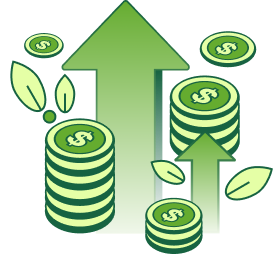Key takeaways
- Start by cutting unnecessary expenses, tracking spending, and avoiding new debt.
- Strategies like the snowball or avalanche method, debt consolidation, and negotiating with creditors can speed up your progress.
- Even small actions, like paying an extra $5 or using cash instead of credit, can help you get out of debt faster.
Paying off debt when you have no money is tough. It can be hard to know where to even start. Take heart in knowing that you are not alone. The Federal Reserve Bank of St. Louis found that delinquency rates (payments at least 30 days late) are rising.
Despite the fact that consumer debt is increasing, there are ways out of this mess. The best place to start depends on how much you owe, your interest rates, and your income. The more strategies you can apply, the faster you’ll be debt-free.
Let’s go over several options to get out of debt so that you can find the method for you.
Ways to get out of debt when you’re broke
Paying off your debts can feel impossible when you’re barely getting by. But here’s the truth: you can do it.
The first step in learning to pay off credit card debt with no money is to stop spending. Resist the temptation to buy on credit. Cut up your cards or place them in the freezer to avoid temptation.
Every dollar you borrow now becomes another you’ll need to repay, with interest. No tips for paying off credit card debt will work if you keep spending on credit.
Pay more than the minimum payment
What happens if you only make the minimum payment on your credit card statement? You’ll stay in debt much longer and pay significantly more. Credit card interest compounds daily. Every month you carry a balance, you accrue interest.
The minimum payment is a financial trap. The best thing you can do is to pay your balance in full. If you can’t afford to pay in full, pay as much as possible. Even a few extra dollars will reduce your balance faster and lessen the interest.
Put an end to overwhelming credit card bills!
Prioritize your debts
When you’re juggling multiple debts, it’s easy to lose focus and become overwhelmed. To get out of credit card debt fast, you need to prioritize them and make a plan. List everything you owe, including due dates, interest rates, and amounts.
Decide whether to try the snowball or avalanche methods. The snowball method is when you put all extra money towards your smallest debt while making minimum payments on all the others. You get quick wins and motivation to keep going.
The avalanche method focuses on the debt with the highest interest rate first. You’ll save more money, but wins are often slower.
Choose a method that motivates you to stay on track. For most people, it’s the snowball method.
Negotiate with creditors
Creditors may negotiate with you because they want you to pay them. You may be able to get them to lower your interest rate, waive late fees, or put you on a payment plan.
Be honest about your financial situation. Ask for a hardship plan, especially if you’re unemployed or recovering from a financial emergency. If the representative cannot help you, call back or ask to speak with a supervisor. When you reach an agreement, get it in writing.
Knowing how to negotiate credit card debt could save you hundreds, or even thousands, in interest charges.
Sell unused items
Look around your home. Chances are, you have electronics, clothes, or other household items collecting dust. Selling these on platforms like eBay, Facebook Marketplace, or Craigslist can generate quick cash.
This won’t clear thousands in debt overnight, but every dollar counts when you’re trying to pay off debt with no money.
Pick up a second job
Side gigs like food delivery, freelance writing, dog walking, or tutoring can bring in extra income that goes straight toward your debt. Even five hours a week can make a difference.
The best part about side gigs is that most of them have flexible schedules that work around you.
You can also pick up more hours at your work or ask for a raise.
Get a credit card consolidation loan
You can use a personal loan to pay off credit card debt. You take out a new loan at a lower interest rate. Then use the proceeds to pay off credit card balances. You’re left with one affordable bill.
Debt consolidation aims to simplify your payments and save money on interest. One bill means that you are less likely to miss a due date. Loans almost always have lower APRs than credit cards.
The same strategy works for payday loan consolidation. Use the money to repay lenders and break the debt cycle.
Before you take out a loan, check that you will save money. An extended repayment period may mean paying more interest. Fees can also negate any savings.
Does debt consolidation hurt your credit? Initially, it will, but overall, it should help. The hard inquiry and new account will temporarily ding your score. Over time, on-time payments and a lower credit utilization ratio can help your score recover.
The key is to pay off the debt. Do not use the loan to move money around.
Consider debt relief programs
If you have no hope of repaying what you owe, consider debt relief options. They may be able to help, but they’re not for everyone.
Debt Management Plan (DMP): Offered by non-profit credit counseling agencies, a DMP combines multiple debts into one payment with reduced interest rates. You’ll work with a counselor to create a plan, usually lasting 3 to 5 years.
Debt Settlement: Debt settlement companies negotiate with creditors to accept less than what you owe. It can reduce your balances but will hurt your credit, involve fees, and you may have to pay income tax.
A credit counselor can walk you through the debt relief programs’ pros and cons based on your personal finances.
If you decide on a settlement, do your research. Read reviews and ask questions like, Is National Debt Relief legit? Plenty of predatory debt relief companies exist.
Don't sink further into debt!
Why is it more difficult to get out of debt when only paying the minimum payment?
Paying only the minimum may seem like you’re staying afloat, but it keeps you stuck in debt for years. The minimum payment is typically 1% to 3% of your balance plus interest. That means most of your payment goes toward interest, not the principal. When you don’t pay down the principal, you’ll accrue more interest, and credit cards have high interest rates.
The CARD Act of 2009 requires credit card companies to include a minimum payment warning on your statement. The warning tells you the total time it will take to pay off your balance and the interest you’ll accrue if you only pay the minimum.
For example, say you have a $1,000 balance on a card with a 21% APR and a minimum payment of $25. If you only pay the minimum, it will take you almost six years to pay off the balance, and you’ll pay $1,734 in interest. Increase your payments by only $5, and you’ll pay off your balance in a little over four years and save $221 in interest. Imagine your savings if you could increase your payments by $10.
How to save money when living paycheck to paycheck
The first step to saving when living paycheck to paycheck is to learn where your money’s going. Track your expenses for at least two weeks to identify any money leaks. Then you’ll know where to cut back.
A few tricks to lessen your spending are:
- Ask service providers (internet, phone, utilities) for lower rates or switch providers
- Change to a lower premium car insurance
- Use public transportation or carpool
- Stock up on items when on sale
- Buy store brands
- Eliminate frivolous spending like coffee and impulse shopping
- Cut back on subscriptions, cable, and streaming services
- Cook at home
- Unplug electronics
Put any money you save towards repaying your debt.
Next, it can help to have a spending plan. Creating a budget lets you plan where your money goes, giving you more control. You are less likely to overspend on frivolous items.
Many people start with the 50/30/20 budget: 50% of your income goes towards needs, 30% to wants, and 20% to debts and savings. This spending plan does not work for everyone, but it is a good place to start.
Another trick is to pay for everything in cash. Psychologically, it is harder to part with physical money than to swipe a card. If you find yourself constantly overspending, go on a cash diet.
Lastly, pay yourself first. When you receive your paycheck, immediately put money towards your debt to avoid spending it.
Being strategic with your money helps you free up cash for debt payments, without needing new cash advance apps.
Frequently asked questions
1. How can you get out of debt with no money and bad credit?
Start by trying to pay down your debts using the snowball or avalanche methods. You can also call your creditors and ask about reduced payments or hardship programs. If your debt is overwhelming, talk to a credit counselor. They may enroll you in a debt management plan.
2. How can you get out of title loan debt?
You can repay the loan, refinance with another loan, renegotiate terms, or explore debt management plans. Selling your car to pay off the loan or declaring bankruptcy may also be options. Act quickly since defaulting can result in the lender repossessing your vehicle.
3. How can you get out of debt without ruining your credit?
Your credit score will drop if you do not manage your debt wisely, which means making minimum payments on time. On-time payments are essential to the snowball and avalanche methods, DMPs, and debt consolidation. Do not enter into debt settlement or bankruptcy, as both will ruin your credit.
4. How can you get out of debt without filing for bankruptcy?
You can get out of debt without declaring bankruptcy. No set number exists for how much debt you need to file bankruptcy, but it should be unpayable. If you have unmanageable debt, consider a DMP first.
Bottom line
Learning how to get out of debt on a low income is tough, but doable. You will have to make sacrifices, but the end is worth it.
Try to pay off the debt yourself first. Call up your creditors and ask for help. Prioritize your payments so that they are more effective. Find extra money by switching to a cheaper phone plan or getting a second job. If you need help or support, go to a credit counselor.
The sooner you become debt-free, the sooner your financial stress will be over.





